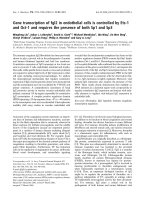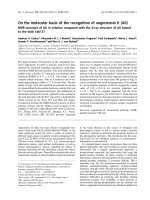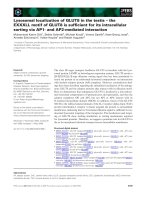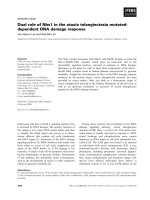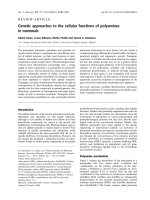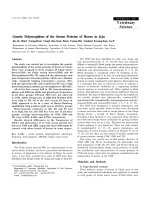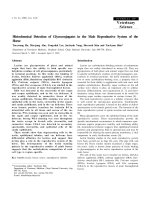Báo cáo khoa học: "Genetic Polymorphism of the Serum Proteins of Horses in Jeju" pps
Bạn đang xem bản rút gọn của tài liệu. Xem và tải ngay bản đầy đủ của tài liệu tại đây (156.63 KB, 9 trang )
J O U R N A L O F
Veterinary
Science
J. Vet. Sci. (2002), 3(4), 255-263
Abstract
2)
The study was carried out to investigate the genetic
polymorphism of the serum proteins of horses in Cheju.
They w ere assigned to three groups; 45 Cheju native
horses(CNH), 60 Cheju racing horses(CRH) and 60
Thoroughbreds(TB). We analyzed the phenotypes and
gene frequencies of serum proteins which were albumin
(Alb), vitamin-D binding protein(GC), esterase (ES),
A1B glycoprotein(A1B) and transferrin(TF) loci using
horizontal polyacrylamide gel electrophoresis (HPAGE).
All of the loci, except A1B in TB, show ed polym or-
phisms and different allelic and phenotypic frequencies
in all three groups. ESS and TFF1 w ere not obse rved
in CNH. Allelic frequencies of AlbB, ESI, TFDand TFF1
w ere high in TB. All of the loci, except ES locus in
CRH, appeared to be in a state of Hardy-Weinberg
equilibrium from
goodness-of-fit
test in all three groups
Heterozygosity estimates at Alb, ES and TF loci
w ere high, but GC and A1B loci were low in all three
groups. Average heterozygosities in CNH, CRH and
TB were 0.3535, 0.3555 and 0.2726, respectively.
Results show ed differences in the frequencie s of
alleles and phenotype s of several serum protein loci
betw een CNH and CRH, suggested that CRH might be
crossed w ith other breeds of horses in some degree.
Key w ords :
serum protein, polymorphism, phenotype,
frequency, heterozygosity, HPAGE, Cheju native horse
Introduction
The Cheju native horses(CNH) are representative of the
native horses in Korea, and have a particular hereditariness
in process of adaptation to the climate of Cheju. In recent
years, it has been assumed that some of CNH have been
hybridized with foreign breeds for racing and riding in farms[7].
*
Corresponding author: Kyoung-Kap Lee
Department of Veterinary Medicine, Agriculture & Life Sciences,
Cheju National University, Jeju, Korea
Tel : +82-64-754-3368, Fax : +82-64-756-3354
e-mail :
The CNH had been identified by color, size, shape and
hair characteristics[10, 12, 13, 21], but these are relatively
difficult to measure[5]. Blood groups and protein polymorphisms
can be revealed by laboratory methods which allow precise
definition and discriminations of variants[4, 5, 7, 9, 16].
Blood grouping is recognized either by clumping of ery-
throcytes(agglutination) or by lysis of erythrocytes(hemolysis)
in the presence of complement. And several kinds of blood
protein are clearly recognized by electrophoresis. Electrophoresis
is a technique that uses an electrical current to separate a
mixture of molecules embedded in a supporting medium
(starch, agarose or acrylamide gel). When applied to blood
protein, electrophoresis can reveal genetic differences between
animals[4]. The items of blood proteins assay by electrophoresis
are usually divided into albumin(Alb), tranferrin(TF),
postalbumin(A1B), hemoglobin(Hb), 6-phosphogluconate dehydro-
genase(6-PGD) and esterase(ES) loci[3, 5, 6, 7, 8, 11, 23].
The CNH were designated as national monuments, and
have been raised specially. Some of them were distributed
to farms and have been used as racing horses at the Cheju
Racing Track, a branch of Korea Racing Association.
Presently, Cheju Institute is very concerned about hybrid of
the CNH with foreign breeds artificially for getting excellent
records when they are in a race. Therefore the preservation
of pure pedigree is very important. There are some reports
of morphology[10, 12, 13, 21], genetic phenotypes and
frequencies of serum proteins of horses in Cheju[7, 9, 14, 16,
17, 20, 22], but there are few reports of genetic comparison
of serum proteins among CNH, CRH and TB.
This study was carried out to find genetic diversity in
CNH, CRH and TB by investigating the phenotypes and
gene frequencies of Alb, GC, ES, A1B, and TF loci which are
authorized internationally among serum proteins, to clarify
the distribution and characteristics of serum proteins of
CNH and to get a basic data for pedigree establishment and
maintenance of purity of the CNH.
Materials and Methods
1) Experim ental animals
Three different groups of horses in Cheju used in this
study and experimental individuals were gathered at random
in each group; 45 Cheju native horses (CNH) which were
Genetic Polymorphism of the Serum Proteins of Horses in Jeju
Jin-Ah Shin1, Young-Hoon Yang2, Hee-Seok Kim1, Young-Min Yun1and Kyoung-Kap Lee1*
1Department of Veterinary Medicine, Agriculture & Life Sciences, Cheju National University, Jeju, Korea
2Department of Animal Biotechnology, Agriculture & Life Sciences, Cheju National University, Jeju, Korea
Received June 27, 2002 / Accepted November 8, 2002
256 Jin-Ah Shin, Young-Hoon Yang, Hee-Seok Kim, Young-Min Yun and Kyoung-Kap Lee
precious national monuments in Jeju Institute for Livestock
Promotion, 60 Cheju racing horses (CRH) which were racing
horses in Jeju Racing Association and 60 Thoroughbreds in
(TB) in Jeju equine stud farm and training center.
2) Sampling
Blood samples were collected from 165 horses (CNH: 45,
CRH: 60, TB: 60) from jugular vein. The samples were
centrifuged at 2,500 rpm for 10 minutes, and then isolated
serum and stored in -72
℃
.
3) Electrophoresis
The polymorphism of serum proteins was analyzed by
horizontal polyacrylamide gel electrophoresis(HPAGE)[24]. The
gel solutions and electrode buffer contents were as follows;
(1) Gel solution
A solution : Acrylamide 32 g, N’-methylenebisacrylamide
0.8 g/DW 100
㎖
B solution : 18% Trisaminomethane 50
㎖
, N,N,N’,N’ -
tetramethylethylenedi-amine (TEMED) 300
㎖
, 2-Mercaptoethanol 150
㎕
/DW 100
㎖
,
adjust pH 7.9 with 1 M citric acid
C solution : Ammonium persulfate 100
㎎
/DW 50
㎖
The compositions of solutions for making suitable gels
were shown in Table 1.
(2) Electrode buffer : Trisaminomethane 7.87 g, boric
acid 1.48 g. pH 9.0
The staining and destaining solutions were as follows;
(1) ES staining : 0.19 M Trisaminomethane 150 ml, 0.05
M Citric acid 200 ml, 1%-Naphthyl acetate (dissolved
in Acetone) 8 ml, Fast blue B salt
(2) Protein staining : Coomassie brilliant blue G 1 g, 60
% perchloric acid 60 ml/DW 1000 ml
(3) Destaining : Methanol 200 ml, acetic acid 70 ml/DW
1000 ml
Polyacrylamide gel was cast between glass plates. A step
gradient of acrylamide concentration of 12%, 4% and 8%
was used in turn. The gel buffer of pH 7.9 was Tris-citrate
and the electrode buffer of pH 9.0 was Tris-borate. Samples
were run simultaneously on a cooling plate at 5
℃
. The
current was at first set at 500 V, 30 W for 8 minutes, after
removing the sample loading papers, and then set at 1200
V, 50 W for 6 hours. The detection of esterase(ES) was stained
in ES staining solution and the other proteins were stained
in protein solution.
4) Statistical analysis
Statistical methods[18] used in this study were as follows;
(1) Allelic frequency : 2 {ii} + {ij} / 2 N = p, q
({ii}, the number of ii homozygotes; {ij}, the number of
heterozygotes having an I allele; N, number of individuals)
(2) Expected number : Ho : p2 ×N, He : 2 pq ×N, Ho‘:
q2 ×N
(3) Chi-square test :
χ
2 = (0 - E) 2 / E
(O, the observed number; E, the expected number )
(4) Heterozygosity : H = 1 q i2
(q, the frequency of the I allele of the gene at this locus)
Chi-square tests carried out to check for significant
differences between observed and expected numbers for
genetic equilibrium of Hardy-Weinberg law.
Results
The image of horizontal polyacrylamide gel electrophoresis
at 12% gel to separate horse blood serum protein was
presented in Fig. 1. According to mobilities, the protein bands
from fast migration to slow migration were albumin(Alb),
vitamin-D binding protein(GC), esterase(ES), A1B glycoprotein
(A1B) and tranferrin(TF) loci in order.
Fig. 1.
Serum protein loci separated on the horizontal
polyacrylamide gel (HPAGE)
Alb: albumin, GC: vitamin-D binding protein, ES: esterase,
A1B: A1B glycoprotein, TF: tranferrin
Table 1.
The composition of polyacrylamide gels
Compone nts A solution Distilled w ater B solution C solution
12% 44.8
㎖
15.2
㎖
30
㎖
30
㎖
4% 2
㎖
8.2
㎖
2
㎖
+ T10
㎕
4
㎖
8% 6
㎖
9
㎖
3
㎖
+ T15
㎕
6
㎖
Genetic Polymorphism of the Serum Proteins of Horses in Jeju 257
1) Genetic polymorphism of Albumin(Alb) locus
Albumin is the most fast migrating protein component on
gel. This locus was controlled by 2 codominant autosommal
allele A and B; phenotypes of albumin were the fast
migrating AA, slow migrating BB and heteotype AB(Fig. 2).
Fig. 2.
Phenotypes of Alb locus separated on the HPAGE
The phenotype BB of TB has the highest frequency in all
three groups. Over all, the frequency of AlbB was higher
than that of AlbA. The frequencies of AlbA and AlbB were
0.433 and 0.567 in CNH, 0.450 and 0.550 in CRH, 0.108 and
0.892 in TB, respectively.
χ
2 values from Hardy-Weinberg
genetic equilibrium test were 0.0742(p>0.05) in CNH,
0.0061(p>0.05) in CRH and 0.1562(p>0.05) in TB.
2) Genetic polymorphism of vitamin-D binding protein
(GC) locus
The GC variants were detected F and S; Fast migrating
FF, slow migrating SS and heterotype FS (Fig. 3).
Fig. 3.
Phenotypes of GC locus separated on the HPAGE
Table 2.
Phenotypes and gene frequencies of Alb locus
Phenotype
No. of heads
Gene
frequency
χ
2-test
Observed Expected
χ
2 df
p
CNH AA 8 (17.8
*
) 8.450
AlbA= 0.433
AlbB= 0.567
AB 23 (51.1) 22.10
BB 14 (31.1) 14.450
total 45 0.0742 1 0.785
CRH AA 12 (20) 12.150
AlbA= 0.450
AlbB= 0.550
AB 30 (50) 29.700
BB 18 (30) 18.150
total 60 0.0061 1 0.938
TB AA 1 (1.7) 0.704
AlbA= 0.108
AlbB= 0.892
AB 11 (18.3) 11.590
BB 48 (80) 47.70
total 60 0.1562 1 0.693
CNH; Cheju native horses, CRH; Cheju racing horses, TB; Thoroughbreds
Table 3.
Phenotypes and gene frequencies of GC locus
Phenotype
No. of heads
Gene
frequency
χ
2 -test
Observed Expected
χ
2 df
p
CNH FF 42 (93.3
*
) 42.050
GCF = 0.967
GCS = 0.033
FS 3 (6.7) 2.900
SS - 0.050
total 45 0.0535 1 0.817
CRH FF 59 (98.3) 59.004
GCF = 0.992
GCS = 0.008
FS 1 (1.7) 0.992
SS - 0.004
total 60 0.0042 1 0.948
TB FF 54 (90) 54.150
GCF = 0.950
GCS = 0.050
FS 6 (10) 5.700
SS - 0.150
total 60 0.1662 1 0.684
258 Jin-Ah Shin, Young-Hoon Yang, Hee-Seok Kim, Young-Min Yun and Kyoung-Kap Lee
The phenotype SS was not observed in all three groups.
The frequencies of GCF and GCS were 0.967 and 0.033 in
CNH, 0.992 and 0.008 in CRH and 0.950 and 0.050 in TB,
respectively.
χ
2 values from Hardy-Weinberg equilibrium
test were 0.0535 (p>0.05) in CNH, 0.0042 (p>0.05) in CRH
and 0.1662 (p>0.05) in TB.
3) Genetic polymorphism of esterase (ES) locus
Three ES variants, F, I and S, showed to be controlled by
codominant alleles; Fast migrating FF, moderate migrating
II, slow migrating SS and heterotype FI, IS and FS (Fig. 4).
Fig. 4.
Phenotypes of ES locus separated on the HPAGE
The frequency of ESI was high in all three groups, and
this was the highest in TB. S allele was not observed in
CNH. The frequencies of ESF, ESI and ESS, were 0.389,
0.611 and 0 in CNH, 0.308, 0.575 and 0.117 in CRH and
0.108, 0.808 and 0.083 in TB, respectively.
χ
2 values from
Hardy-Weinberg equilibrium test were 0.5613 (p>0.05) in
CNH, 10.3885 (p<0.05) in CRH and 4.5567 (p>0.05) in TB.
4) Genetic polymorphism of A1B glycoprotein(A1B) locus
Generally, three allelic variants F, K and S were detected
according to mobilities, but this locus was detected K and S
variants in this study (Fig. 5).
Fig. 5.
Phenotypes of A1B locus separated on the HPAGE
In TB only phenotype KK was detected. The frequencies
of A1BK and A1BS in CNH, CRH and TB were 0.967 and
0.033, 0.983 and 0.017, 1 and 0, respectively.
χ
2 values from
Hardy-Weinberg equilibrium test were estimated to be 0.0535
(p>0.05) in CNH, 0.0172(p>0.05) in CRH.
Table 4.
Phenotypes and gene frequencies of ES locus
Phenotype
No. of heads
Gene frequency
χ
2 -test
Observed Expected
χ
2 df p
CNH FF 8 (17.8
*
) 6.806
ESF= 0.389
ESI = 0.611
ESS = 0
II 18 (40) 16.806
SS - -
FI 19 (42.2) 21.389
IS - -
FS - -
total 45 0.5613 1 0.454
CRH FF 11 (18.3) 5.704
ESF = 0.308
ESI = 0.575
ESS = 0.117
II 24 (40) 19.838
SS 1 (1.7) 0.817
FI 12 (20) 21.275
IS 9 (15) 8.050
FS 3 (5) 4.317
total 60 10.3885 3 0.016
TB FF 2 (3.3) 0.704
ESF = 0.108
ESI = 0.808
ESS = 0.083
II 39 (65) 39.204
SS - 0.417
FI 9 (15) 10.508
IS 10 (16.7) 8.083
FS - 1.083
total 60 4.5567 3 0.207
Genetic Polymorphism of the Serum Proteins of Horses in Jeju 259
5) Genetic polymorphism of Transferrin(TF) locus
TF locus was detected D, F1, F2, H2, O and R in order
of decreasing mobility to the anode (Fig. 6).
Fig. 6.
Phenotypes of TF locus separated on the HPAGE
There were 21 different phenotypes and 6 alleles at TF
locus. F1 allele was not observed in CNH, but was observed
in CRH. F2 and R alleles were high in CNH, D, F2 and R
alleles were high in CRH, D, F1 and F2 alleles were
quantitative in TB.
χ
2 from Hardy-Weinberg equilibrium
test were 9.8776(p>0.05) in CNH, 11.5255(p>0.05) in CRH
and 12.1406(p>0.05) in TB(Table 6).
6) Average heterozygosity
The heterozygosity reflects the variety of sources from
which this breed is being created. Calculated heterozygosity
were estimated to be 0.4911, 0.4950 and 0.1932 at Alb locus,
0.0644, 0.0165 and 0.0950 at GC locus, 0.4753, 0.5607 and
0.3279 at ES locus, 0.0646, 0.0328 and 0 at A1B locus
0.6723, 0.6725 and 0.7467 at TF locus in CNH, CRH and
TB, respectively. The TF locus showed the highest value at
5 protein loci. Heterozygosity values of TB were low at all
loci, especially A1B locus, but value of TF locus was high.
Average heterozygosity values ranged from 0.2726(TB) to
0.3555(CRH). TB had the lowest value compared with the
other groups. Heterozygosity values of Alb, ES and TF loci
were high, but GC and A1B loci were low(Table 7).
Table 5.
Phenotypes and gene frequencies of A1B locus
Phenotype
No. of heads
Gene frequency
χ
2-test
Observed Expected
χ
2 df p
CNH FF - -
A1BF = 0
A1BK = 0.967
A1BS = 0.033
KK 42 (93.3*) 42.050
SS - 0.050
FK - -
KS 3 (6.7) 2.900
FS - -
total 45 0.0535 1 0.817
CRH FF - -
A1BF = 0
A1BK = 0.983
A1BS = 0.017
KK 58 (96.7) 58.017
SS - 0.017
FK - -
KS 2 (3.3) 1.967
SS - -
total 60 0.0172 1 0.896
TB FF - -
A1BF = 0
A1BK = 1
A1BS = 0
KK 60 (100) 60
SS - -
FK - -
KS - -
SS - -
total 60 1
Table 6.
Phenotypes and gene frequencies of tranferrin(TF) locus.
Phenotype
No. of heads
Gene
frequency
χ
2-test
Observed Expected
χ
2 df p
CNH DD 1 (2.2*) 0.356
TFD = 0.089
TFF1 = 0
TFF2 = 0.478
TFH2= 0.011
TFO = 0.244
TFR = 0.178
DF1 - -
DF2 5 (11.1) 3.822
DH2 0.089
DO 1 (2.2) 1.956
DR 1.422
F1F1 - -
F1F2 - -
F1H2 - -
F1O - -
F1R - -
F2F2 10 (22.2) 10.272
F2H2 0.478
F2O 10 (22.2) 10.511
F2R 8 (17.8) 7.644
H2H2 - 0.006
H2O 1 (2.2) 0.244
H2R 0.178
OO 4 (8.9) 2.689
OR 2 (4.4) 3.911
RR 3 (6.7) 1.422
total 45 9.8776 10 0.451
CRH DD - 0.817
TFD = 0.117
TFF1 = 0.042
TFF2 = 0.508
TFH2= 0.058
TFO = 0.058
TFR = 0.217
DF1 - 0.583
DF2 9 (15) 7.117
DH2 2 (3.3) 0.817
DO - 0.817
DR 3 (5) 3.033
F1F1 - 0.104
F1F2 2 (3.3) 2.542
F1H2 - 0.292
F1O - 0.292
F1R 3 (5) 1.083
F2F2 15 (25) 15.504
F2H2 3 (5) 3.558
F2O 6 (10) 3.558
F2R 11 (18.3) 13.217
H2H2 - 0.204
H2O - 0.408
H2R 2 (3.3) 1.517
OO - 0.204
OR 1 (1.7) 1.517
RR 3 (5) 2.817
total 60 11.5255 15 0.715
260 Jin-Ah Shin, Young-Hoon Yang, Hee-Seok Kim, Young-Min Yun and Kyoung-Kap Lee
Genetic Polymorphism of the Serum Proteins of Horses in Jeju 261
Discussion
Horizontal polyacrylamide gel electrophoresis was
resulted in a separation of proteins, according to mobilities;
albumin(Alb), vitamin-D binding protein(GC), esterase(ES),
A1B glycoprotein(A1B) and tranferrin(TF) loci were given
for CNH, CRH and TB. Mogi et al reported that Alb locus
is controlled by A and B alleles, and there are genetic
differences in frequency between Asia and European’s horses
[15]. It was reported that GC locus is comprised of F and
S alleles[3, 5] and ES locus is comprised of F, G, H, I, S,
O and R alleles[5]. Andersson and Cho et al reported that
A1B locus is controlled by F, K and S alleles and the
frequencies were different between breeds[1, 7]. Yokohama
et al and Schmid Braend reported that TF is identified 14
alleles, C, D1, D2, D, F1, F2, F3, G, H1, H2, J, M, O, R and
silent, and phenotypes are different between breeds[19, 22].
In this study, restricted alleles were accomplished by
HPAGE.
Studies for CNH have been reported of Alb locus[7, 16,
17], GC locus[14, 7], ES locus[7, 16, 17, 22], A1B locus[7, 14,
17], TF locus[7, 22], almost all of their results appeared to
be similar to these results. But at GC locus, results (GCF,
0.411; GCS, 0.589) of Kim et al showed differences in
frequencies[14], it is probably due to a difference of population
examined. And at ES locus, results (ESF, 0.274; ESI, 0.479;
ESS, 0) of Cho et al showed somewhat different frequencies[7].
It is considered that the differences were due to the
electrophoresis method. And S allele of ES locus and F1
allele of TF locus in this study were not observed, this could
Phenotype
No. of heads
Gene
frequency
χ
2-test
Observed Expected
χ
2 df p
TB DD 8 (13.3) 6.338
TFD = 0.325
TFF1 = 0.317
TFF2 = 0.192
TFH2= 0.025
TFO = 0.075
TFR = 0.067
DF1 9 (15) 12.350
DF2 8 (13.3) 7.475
DH2 2 (3.3) 0.975
DO 2 (3.3) 2.925
DR 2 (3.3) 2.601
F1F1 7 (11.7) 6.017
F1F2 7 (11.7) 7.283
F1H2 - 0.950
F1O 4 (6.7) 2.850
F1R 4 (6.7) 2.535
F2F2 3 (5) 2.204
F2H2 1 (1.7) 0.575
F2O 1 (1.7) 1.725
F2R - 1.534
H2H2 - 0.038
H2O - 0.225
H2R - 0.200
OO 1 (1.7) 0.338
OR - 0.600
RR 1 (1.7) 0.267
total 60 12.1406 15 0.668
Table 7.
Heterozygosity of serum proteins in three groups
Locus CNH CRH TB
Alb 0.4911 0.4950 0.1932
GC 0.0644 0.0165 0.0950
ES 0.4753 0.5607 0.3279
A1B 0.0644 0.0328 0
TF 0.6723 0.6725 0.7466
Average 0.3535 0.3555 0.2726
262 Jin-Ah Shin, Young-Hoon Yang, Hee-Seok Kim, Young-Min Yun and Kyoung-Kap Lee
be also identified by Yokohama et al and Cho et al[7, 22].
Cho et al reported of CRH at Alb, GC, ES, A1B and TF
loci[7]. The phenotypes and frequencies in this study were
similar to previous study. But at Alb locus, his results (AlbA,
0.280; AlbB, 0.720) showed differences in frequency. At ES
locus, his results (ESF, 0.203; ESI, 0.661; ESS, 0.076) showed
slight differences in frequency, it is considered that the
differences were due to the electrophoresis method.
Studies for TB have been reported of Alb locus[5, 11, 15],
GC locus[5], Es locus[5, 11, 22], A1B locus[5, 11] and TF
locus[3, 5, 11, 22], these present results appeared to be
similar to previously described results. TB were
characterized by a very large preponderance of ESI and TB
which had only the phenotype KK showed monomorphism
at A1B locus in this study.
Over all, the frequency of AlbB was higher than that of
AlbAand especially TB had higher proportions of AlbB than
other groups. In this study F allele of GC locus was
observed predominantly. Phenotype II was high at ES locus.
And phenotype KK was the highest and F allele was not
observed at A1B locus. The frequency of TFF1 was about two
times higher than that of TFF2 in TB, while F1 allele lacked
in CNH and was rare in CRH. In CNH, lacking of F1 allele
could be also identified by Yokohama et al and Cho et al[7,
22]. The frequencies of D and F1 alleles in TB were the
highest in all three groups, these results were similar to
those of Kaminski et al and Yokohama et al[11, 22]. The
occurrence of ESS and TFF1 in CRH, even though at low
frequencies, is one of difference between CRH and CNH,
lacking of these variants and the relatively frequencies of
ESS and TFF1 in TB were high.
A Chi-square test to determine whether the fit is
sufficiently close to expected Hardy-Weinberg proportion
revealed that almost of all the polymorphic loci, except ES
locus in CRH, showed to be in genetic equilibrium in all
three groups. Result of ES in CRH suggested that CRH
have been selectively bred as racing horses in farms.
Heterozygosity estimates at Alb, GC, ES, A1B and TF loci
were reported previously for CNH and CRH by Cho et al[7].
His results appeared to be similar to these results. But
these results were different from previous results at GC
locus in CNH, and A1B locus in CNH and CRH. TB showed
the lowest value all of the loci, except TF locus. It might be
from the relationship between individuals within small
pedigreed data. Heterozygosity of CNH and CRH showed
higher than TB, suggested that these groups are different
from TB.
In conclusion, these results of genetic polymorphisms and
equilibrium in blood serum proteins loci and the other
reports of morphological characteristics[13, 21] indicated
that CRH might be a hybrid or mixed population between
CNH and TB or other imported breed.
References
1. Andersson, L., Juneja R.K. and Sandberg K. Animal
Blood Groups Biochemical Genetics. 14, 45-50, 1983.
2. Bell, K. Blood protein polymorphisms in the donkey
[Equus asinus]. Animal Genetics. 1994, 25 suppl 1,
109-113.
3. Bell, K., Pollitt C.C. and Patterson S.D. Subdivision of
equine Tf into H1 and H2. Animal Genetics. 1988, 19,
177-183.
4. Bowling, A.T. Horse Genetics. CAB INTERNATIONAL.
pp.82-154. 1996.
5. Bowling, A.T. and Clark, R.S. Blood group and protein
polymorphism gene frequencies for seven breeds of
horses in the United States. Animal Blood Groups and
Biochemical Genetics. 16, 93-108, 1985.
6. Bowling, A.T. and Ryder, O.A. Genetic studies of blood
markers in Przewalski's horses. The journal of Heredity.
1987, 78, 75-80.
7. Cho, G.J ., Kim, B.H., Lee, D.S. and Lee, K.K. Genetic
studies of blood markers in Cheju horses II Blood
protein types. Korean j Vet Res. 2000, 40(2), 283-290.
8. Cothran, E.G., MacCluer, J.W., Weitkamp, L.R. and
Bailey, E. Genetic differentiation associated with gait
within American Standardbred horses. Animal Genetic.
1987, 18, 285-296.
9. Han, S.K., Chung, E.Y., Shin, Y.C. and Byun, H.D.
Studies on Serum Proteins and Enzyme Polymorphisms
for Conservation of Cheju Native Horses. Korean J.
Anim. Sci. 1995, 37(1), 52-58.
10. Jung, C.J., Yang, Y.H., Kim, J .K. and Kang, M.S.
Studies on the Classification for the Registration of the
Cheju Native Horse I. Body measurements by location
sex and age. Korean J. Anim. Sci. 1991, 33(6), 418-422.
11. Kaminski, M. and Damian, F. Electrophorestic markers
of Andalusian Horses: Comparison of Spanish and lusitanian
lineages. Comp. Biochem. Physiol. 1986, 83B(3), 575-588.
12. Kang, M.S., Choung, C.C., Kang, T.S. and Choung, J.J.
Coat Color Frequencies in the Cheju Island Pony. Cheju
National University. 1988, 3, 129-132
13. Kang, M.S., Choung, C.C., Kang, T.S., Park, H.S., Kim,
D.H. and Choung, J.J . Study on the Body Type of
Cheju Native Horses. Cheju National University. 1986,
1, 119-125.
14. Kim, S.Y., Kang, M.S. and Jung, C.J. Study of blood
protein polymorphism of Cheju native horses. Cheju
National University. 1993, 313-317.
15. Mogi, K., Abe, T. and Hosoda, T. Studies on serum
protein types in horses. I. Classification and inheritance
of transferrin and serum albumin types and efficacy of
their typing in determining of doubtful parentage. Jap.
J. Zootech. Sci. 1970, 41(8), 400-406.
16. Oh, M.Y., Ko, M.H., Kim, K.O., Kim, S.J., Chung, C.C.
and Kim, K.I. Genetic variations of the blood proteins
in Cheju Native Horses. Korean J. Genetics. 1992, 14(1),
39-50.
17. Oh, Y.S., Oh, M.Y., Kim, S.J., Kim, K.O., Ko, M.H. and
Genetic Polymorphism of the Serum Proteins of Horses in Jeju 263
Yang, Y.H. Polymorphisms of Blood Proteins in Cheju
Native Horses and Tsushima Native Horses. Korean J.
Zool. 1995, 38, 324-329.
18. Pasteur, N. and Pasteur, G. Practical isozyme genetics:
Ellis horwood limited. pp. 165-189, 1988.
19. Schmid, D.O., EK, N. and Braend, M. Further evidence
for a silent allele in the transferrin locus of the horse.
Animal Genetics. 1990, 21, 423-426.
20. Shin, J.A., Kim, S.H., Kim, Y.H., Chun, C.I. and Lee,
K.K. Genetic Polymorphism of Serum Protein in Horses
on Cheju. J. Res. Ins. Anim. Sci. 1999, 14, 149-157.
21. Yang, Y.H., Jung, C.J., Lee, H.J. and Kang, T.S. Studies
on the Classification for the Registration of the Cheju
Native Horse. Korean J. Anim. Sci. 1991, 3(6), 438-443.
22. Yokohama, M., Watanabe, Y. and Kobayashi, E. Classi-
fication for Transferrin and Esterase types in Horses.
Jpn. J . Zootech. Sci. 1989, 60(2), 115-120.
23. Yokohama, M., Watanabe, Yand. and Mogi, K. A New
Equine Transferrin phenotype Detected by Isoelectric
Focusing. Jpn J. Zootech, Sci. 1985, 56(2), 116-121.
24. Yokohama, M., Watanabe, Y., Gawahara, H. and Kobayashi,
E. Horizontal Polyacrylamide Gel Electrophoresis for
Equine Serum Protein Types. ABRI. 1987, 15, 22-27.

